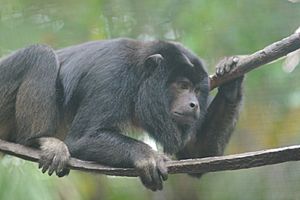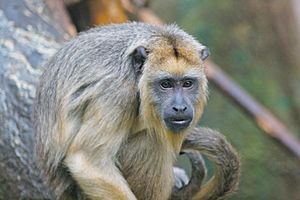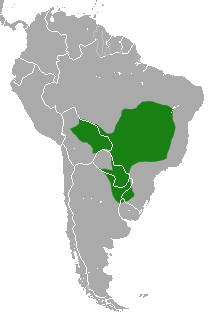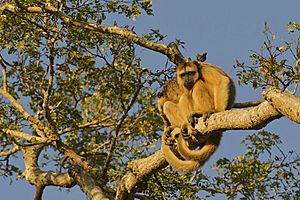Black howler facts for kids
Quick facts for kids Black howler |
|
|---|---|
 |
|
| Male | |
 |
|
| Female Both photographed at Pittsburgh Zoo |
|
| Conservation status | |
| Scientific classification | |
| Genus: |
Alouatta
|
| Species: |
caraya
|
 |
|
| Black Howler range | |
The black howler (Alouatta caraya), also known as the black-and-gold howler, is a type of monkey. You can find it in parts of Paraguay, southern Brazil, eastern Bolivia, northern Argentina, and Uruguay.
Adult male black howlers have completely black fur. Females and young monkeys of both sexes have golden-colored fur. This difference in color gives them their name. The IUCN Red List says the black howler is a "Near Threatened" animal. This means its population has recently gone down because of things humans do.
Contents
About Black Howlers
The black howler is one of nine species in the Alouatta group of monkeys. These monkeys belong to the Atelidae family.
What do black howlers look like?
Male and female black howlers look different because of their fur color. As a male black howler grows up, its fur changes from golden to completely black. Females and young monkeys of both sexes keep their golden fur.
Female howlers are lighter than males. Males can be up to 47% heavier, weighing between 6 kg and 7.7 kg. Black howlers have prehensile tails. This means their tails can grasp things, like a fifth limb. This helps them climb well and stay comfortably in tree branches.
How do black howlers behave?
Black howlers are famous for their loud 'howl'. This powerful sound helps them show their territory. It also helps them keep a safe distance from other groups of howler monkeys. These monkeys rarely come down to the ground.
What do black howlers eat?
Black howlers mostly eat leaves, which is called being folivorous. But they also enjoy other foods. Their diet can include fruits, figs, mosses, tree bark, seeds, and flowers.
How do black howlers live in groups?
Howler monkeys usually live in groups. Often, there is one main male, several adult females, and their babies. In bigger groups, the mix of howler monkeys can change. A study in 2009 looked at black-and-gold howler groups in southern Brazil. It found that group sizes were usually between 6 and 18 monkeys. These groups often had more males than females.
Where do black howlers live?
Black howlers live in parts of Central and South America. You can find them in Paraguay, southern Brazil, eastern Bolivia, northern Argentina, and sometimes in Uruguay.
Howler monkeys can live in many different forest environments. They have been seen in tropical and subtropical forests. They can even survive in areas changed by humans. This includes places near farms or towns.
Protecting Black Howlers
The IUCN Red List lists the black howler as a "Near Threatened" animal. This is because their numbers are going down. Many things cause this, like losing their homes and being hunted.
Hunting and the illegal pet trade also reduce the black howler population. Black howlers can also get sick easily. For example, outbreaks of sylvatic yellow fever in Brazil have caused many howler monkeys to die.
Cool Facts About Black Howlers
- The black howler is one of the largest New World monkeys.
- A howler's 'howl' is one of the loudest sounds made by any primate. You can hear it up to two kilometers (about 1.2 miles) away!
- They are also one of the least active types of primates. They spend about 60-70% of their day resting or sleeping.
- Howlers have a special digestive system. It helps them digest leaves quickly. They also have strong molar teeth to chew tough leaves.
- Male black howlers have a larger hyoid bone than females. This bone is thought to act like a sound box, making their howls even louder.
See also
 In Spanish: Mono carayá negro para niños
In Spanish: Mono carayá negro para niños




